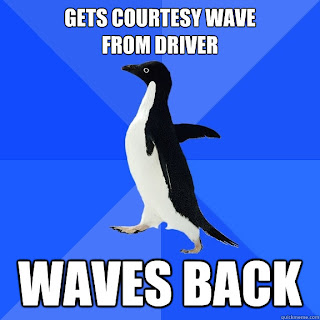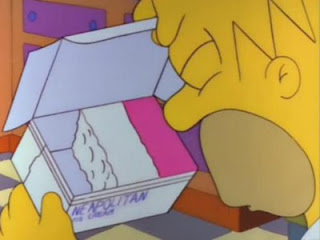Vroooom, vrooom, vrooom, Shrump.
Rush rush. Cut. Cut. Go.
Vroooom, vrooom, vrooom, Shrump.
Rush rush. Cut. Cut. Go.
This is the best I could
onomatopoeia-ically describe the sound of me getting cut off. Twice. Normally,
cutting someone off is viewed as both a threat to life and adequate driving
skills. However, in this case, I'm actually okay with the situation. Why? Because
the cutters made certain to shoot me a courtesy wave and
ameliorate the situation.
For those who have never touched an
automobile before, here is the background on a courtesy
wave. In the world of cars, when someone does you a solid, something that saves
your life in some way, like letting you merge from a ramp—thus preventing you
from smashing into those big yellow barrels that I can only assume contain some
sort of fuel and accelerant that would explode like it's in a mid-90s era light
gun game. When situations like that occur, the solid-receiver is expected to
throw up a wave to courteously let the other driver know they’re giving
respect. It also lets them say “I’m an idiot, thanks” without having to
verbalize it.
 |
| Courtesy wave, driver lives. |
Not only are courtesy
waves courteous, they've also come to be expected. If you don't do one, bad
things are likely to happen. The case of William S. Brooks is proof positive of
the power of the courtesy wave. In 1996, he was driving
to his home in Olympia, WA, when Brian Michaelson, a 30-year-old roofing contractor
cut him off. In Brooks' words, it wasn't a “bad cutoff,” but a cutoff
nonetheless. He waited the requisite 7.3 seconds to see if Michaelson did shoot
up the courtesy wave.
When no wave came, Brooks proceeded
to run Michaelson off and repeatedly shoot him with a crossbow he kept in the
back of the cabin of his Ford F-150. After Michaelson expired, Brooks
reportedly waved at him before getting back in his car and continuing his
drive.
At trial, Brooks took the stand and
mentioned the lack of courtesy wave and how this made him
feel sad. It took the jury 20 minutes to find him not guilty on all accounts.
And that justified jury of course got a strong courtesy
wave from Brooks, the purveyor of kindness.
 |
| Thanks, driving penguin! |
As Mr. Brooks' case shows, the courtesy wave has much power on the road and in the minds of
feeble-minded juries. But it seems to be relegated to only driving or biking
sorts of situations. I'd like to see the wave crawl out of the car ghettos and
apply it to other parts of life.
“Oops, sorry I Ponzi schemed you
(wave),” - Bernie Madoff.
“I'll get you in your dreams
(wave),” Freddy Krueger—made doubly scary because the claw hand is doing the
wave.
“So long, Mr. William S. Brooks
(wave),” - Miranda Michaelson.
“Sorry I needed to go back to the
well and make another X-Files movie that really sucked. Cheers,” Chris Carter
says very Britishly as he raises his right hand in a conciliatory fashion.
Apology accepted Mr. X-Files, just don't do it again.
While the courtesy
wave has courtesy in the title, it's really a common
expectation. If you don't do it, nobody likes you and you're a horrible person.
Please, always courtesy wave, it's the right thing to do.
So feel free to vroom and shrump on
the road, just make sure to do it courteously.





